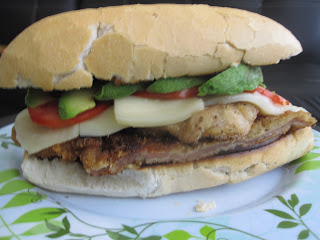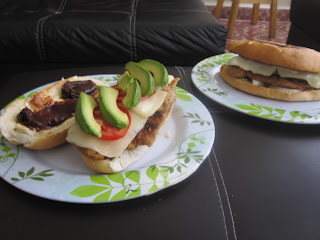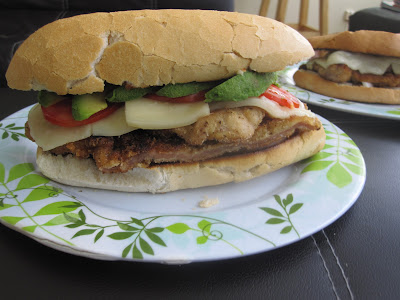As a child, I always hated "Sandwich Night"; a few slices of cold cuts and some American cheese on a kaiser roll never really piqued my culinary interest. And while I have yielded on the cold cuts a bit in my culinary maturity (which would have happened a long time ago if my parents had involved roast beef and swiss cheese in the equation), the Mexican option of the "
milanesa" sandwich has really changed my attitude towards sandwiches in general.
"
Milanesa" is the term used to refer to a very thin piece of meat (any kind, beef, pork, chicken, etc..) that is breaded and fried (schnitzel, according to the dictionary).
Milanesa beef or pork is most popular in the
torta carts, and these are "
torta cart" style of
tortas (vs. "
taqueria" style
torta", which I will save for another day). That means more vegetable toppings, whole pieces of meat, and refried beans.
Ingredients
4 pork cutlets, pounded super thin and flat

1 cup flour
1 egg
1 cup breadcrumbs (or Panko, if you like to be trendy)
salt and pepper
oil for frying
4
bolillos (or kaiser rolls, I guess)
butter
mayonnaise
1 cup refried beans
1/2 pound of quesillo (or any mild white melting cheese), sliced or shredded
1 tomato, sliced
1 avocado, sliced
1 red onion, sliced
1 can of
chiles chipotles or jalapenos in vinegar
Directions
1 - Fry up your
milanesas. Fill three shallow dishes with the flour, egg, and breadcrumbs, respectively, all seasoned to taste. Heat a half an inch of oil in a large skillet over medium heat. Dip the pork in the flour, then the egg, then the breadcrumbs. Cover completely. Fry the
milanesas for about 4 to 5 minutes on each side. Set aside.
2 - Fold/cut
milanesas into sandwich size/shape pieces. Return each
milanesa stack to a dry skillet over low heat. Place the cheese on top and cover the pan with foil to melt the cheese. Turn the heat off after a minute or so, and let the cheese keep melting.
3 - The rest is pretty much
al gusto, but a complete sandwich (in my home) would have the
bolillo toasted with a bit of butter; a smear of refried beans on one half and a smear of mayo on the other; a row of sliced onions, the meat and cheese; topped with tomatoes, avocados, and the
chiles of your choice (but not both).
4 - The best way to do "
Torta Night" is to set it up buffet style and let everyone put as much or as little of each of the toppings as they like, and then truly enjoy their
torta milanesa.
PS - These have nothing to do with Milan; I have no idea why they are called that.
 I have discussed my dislike for fruit before, but the ways that some fruits are being prepared here are really making me change my mind.
I have discussed my dislike for fruit before, but the ways that some fruits are being prepared here are really making me change my mind.




